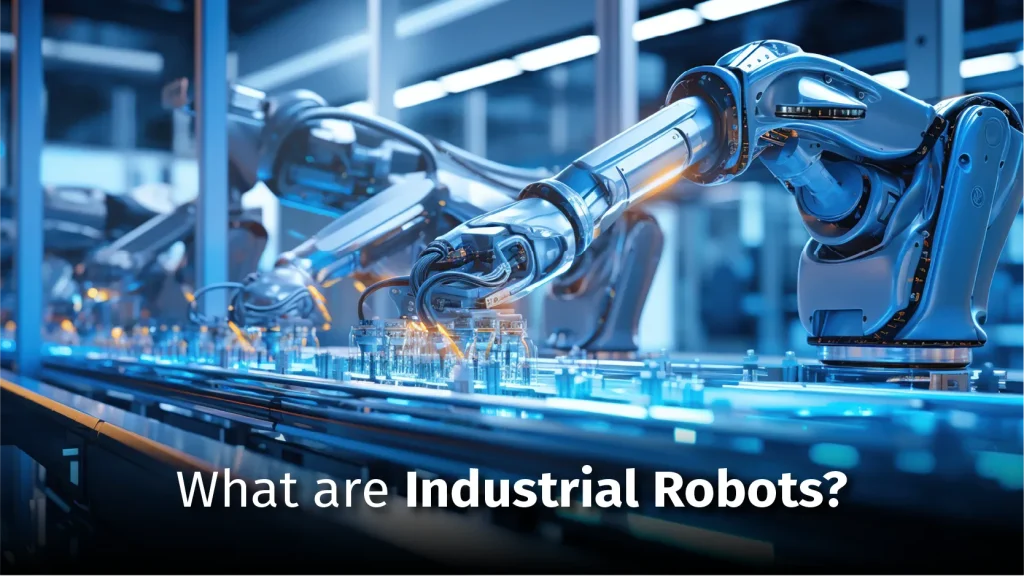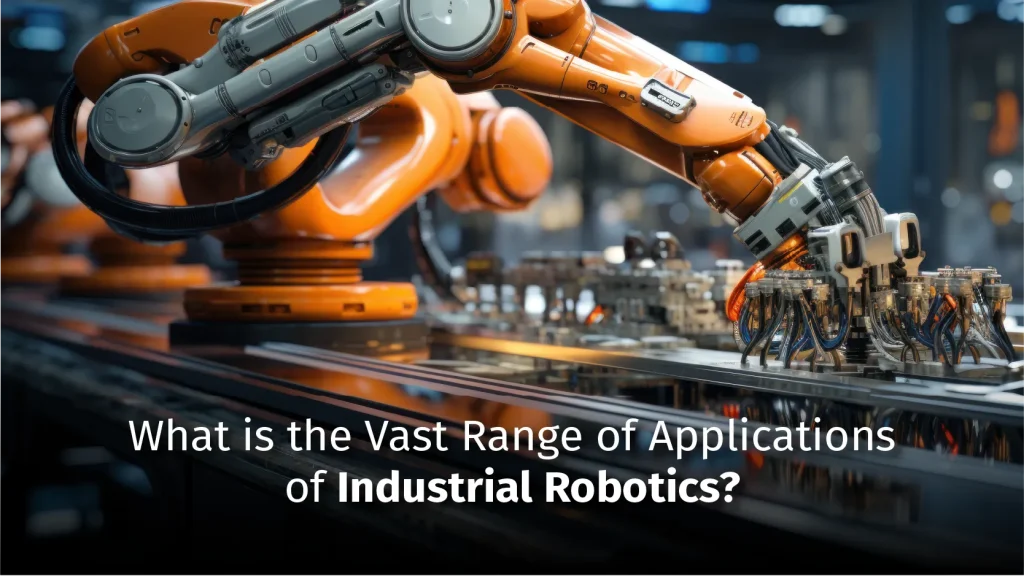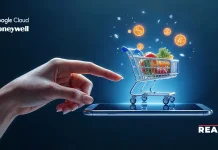From manufacturing units to agricultural lands, there is an increasing number of places and scenarios where industrial robots can be utilized. These industrial robotics garner more attention because they address bottlenecks like labor shortages and expand business opportunities.
According to the International Federation of Robotics (IFR), over 590,000 new industrial robots will be installed worldwide in 2024, reflecting a 7% growth rate compared to previous years.
As they are highly versatile and flexible, one of the significant benefits of industrial robotics is that they are seamlessly deployable to sites where implementing specialized machines is not an ideal option. In this blog, let us have a look at the definition of industrial robotics, its applications, and benefits:
What are Industrial Robots?

Industrial robots in production lines are automated pre-programmed machines that execute industrial tasks such as inspecting, welding, gluing, picking, and placing. Additionally, it also has the capability to execute a series of pre-defined actions on any object or operation.
These robots repeat the task on x number of units in bulk volume and low-hanging tasks.
Industrial robots will not get bored or tired from their tasks and execute each action precisely and accurately. They also have applications for executing slightly different tasks each time by leveraging smart tools and sensors such as cameras and lasers to adapt to what they are doing. Industrial robotics finds applications in vast industries, which we will cover in the next segment.
What is the Vast Range of Applications of Industrial Robotics?

Following are some of the wide range of applications that industrial robots could be used in:
● Liquid Handling
Labs and pharmaceutical production lines require industrial robots to automate their liquid handling processes. The application of industrial robotics in pharmaceuticals is to simplify tasks, including pipetting. This ensures better accuracy in the operations and reduces the risks of human mistakes. It is an effective way to enhance efficiency and enables technicians to prioritize more crucial aspects of their operations.
● Handling & Picking
The demand for handling and picking robots is witnessing a significant increase because of the rising e-commerce operations globally. It executes tasks such as migrating the goods or products within the warehouse and completing the orders with precision. Autonomous mobile robots (AMRs) and forklifts minimize the requirements of labor while improving safety and productivity.
AMRs have the potential to maneuver through the warehouse autonomously avoiding obstacles. Hence, they are more flexible than traditional conveyor systems. This adaptability allows seamless adjustments to operations as requirements change.
● Casting & Molding
Industrial robotics plays a vital role in casting and molding by minimizing human risk and enhancing the output. These robots improve productivity in die casting or injection molding by automating tedious tasks including material removal and cooling.
● Welding & Soldering
Any industrial operation will have welding robots at the core of its applications. It is widely popular for its capability to create precise and repeatable welds. High-risk tasks such as arc and spot welding are executed by these robots. As a result, there are fewer chances of injury, and ensures consistent product quality. Laser welding is a substitute that is widely known for its precision and minimal requirement for post-processing.
● Cleaning & Hygiene
Autonomous cleaning robots streamline the maintenance of industrial facilities. It handles everything from floor cleaning to surface disinfection. These robots improve workplace hygiene without the need for manual labor. Hence, these industrial robotics are a reliable solution for modern industrial settings.
● Packing & Palletizing
Robotic packing and palletizing systems accelerate the process and reduce the physical strain on workers. Businesses can increase output by automating these repetitive tasks while minimizing the risk of injury.
● Machining and Cutting
One of the significant benefits of industrial robotics is to transform the machining and cutting processes by improving precision and security. These robots have remarkable accuracy and reduce the exposure of the workforce to harmful conditions. Milling, drilling, and tapping are a few of the tasks that robotic arms are capable of executing while maintaining quality and efficiency consistency.
● Assembly & Dispensing
Assembly robots have transformed manufacturing by taking over tasks that once required human dexterity. They now handle assembling parts and dispensing adhesives with precision and consistency. Traditionally fixed to floors or overhead rails, these robots come in XYZ or six-axis configurations, increasing their flexibility.
The automotive industry pioneered the use of assembly robots, but their application has expanded significantly. The high-speed, accurate assembly done by these robots ensures better throughput and precision than manual labor.
● Finishing and Sanding
Robots that finish tasks like deburring, grinding, and polishing ensure smooth, high-quality surfaces. They eliminate the fatigue associated with manual processes, achieving consistent results with greater speed and precision.
● Inspection & Quality Control
Inspection robots with advanced vision systems are setting new standards in quality control. They are able to achieve higher accuracy levels that are unattainable by manual inspection. These robots ensure that only defect-free products reach the market. As a result, businesses can enhance their customer satisfaction.
● Logistics & Storage
Warehouse robots revolutionize logistics by simplifying tasks including transportation, picking, and packing. There has been a significant increase in the adoption of AMRs and Automated Guided Vehicles (AGVs). This trend showcases a shift toward warehouse automation. The main goal is to increase the efficiency and minimize the costs.
● Painting & Coating
Painting and coating robots offer significant advantages by delivering uniform applications, whether for industrial equipment or even building walls. They serve as a catalyst by speeding up processes. It can reduce waste and exposure to harmful substances and improve overall safety.
● Harvesting
In agriculture, harvesting robots equipped with AI and soft grippers handle delicate crops with care. This approach minimizes waste and maximizes yield. Their ability to determine ripeness and handle produce gently makes them indispensable for modern farms.
There are widespread applications of industrial robots across various sectors. Business decision-makers are exploring opportunities to embrace industrial robots in their operations to streamline production and enhance productivity. Because of the immense benefits of industrial robotics, the world will witness significant growth in its adoption.
Also Read: 5 Use Cases of Edge AI Chips in 2024
Benefits of Industrial Robotics
The adoption of industrial robots has a significant benefit for the organization. Let us dig in one by one!
1. Improved Working Conditions
Robots improve workplace safety by taking care of dangerous and unpleasant tasks. Thanks to industrial robots, the workforce does not have to work in dusty, hot, and hazardous conditions. Rather, they can focus on upskilling and contributing to much safer and simulating work ecosystems.
2. Enhanced Product Quality
Industrial robotics offers more precision to production lines that are difficult to find. Their capabilities to execute repetitive tasks without feeling tired or getting distracted results in consistent and high-quality results. Compared to humans, robots do not feel distracted or tired. It ensures that every product has the same quality standards.
3. Enhanced Safety and Security
Industrial robots significantly minimize the production floor risks. It has the potential to manage tedious and risky tasks. As a result, it has the capability to prevent the workforce from getting injured or avoid health risks related to repetitive tasks. Automation of such processes will help organizations have fewer occurrences of repetitive strain injuries and other work-related conditions.
4. Creating Better Jobs, Not Taking Them Away
The workforce is hurdled with the preconceived notion that robots are here to take away their jobs. In reality, robots are here to automate repetitive tasks by freeing humans to emphasize roles that need logical thinking, problem-solving, and capability. With significant advancements in automation, it is opening up new career opportunities in robot programming, maintenance, and process optimization.
5. Unmatched Efficiency and Output
Robots do not require breaks like humans do, they can work around the clock. They help boost productivity and scale operations seamlessly.
6. Enhanced Accuracy and Consistency
Human mistakes are unavoidable when there are humans involved in the operations. These mistakes should be anticipated and accounted for in any organization’s operations. Robots have the capability to excel in precision and consistency. They deliver spotless results by significantly cutting down on errors and waste while enhancing accuracy and reliability.
7. Minimizing Waste, Maximizing Yield
By streamlining production, robots reduce waste and enhance yield. They consistently deliver high-quality products on the first attempt, cutting down on material waste and ensuring a higher rate of finished goods that meet customer standards.
8. Flexible Manufacturing
One of the most significant advantages of robots is their adaptability. Once programmed, they can easily switch between tasks, making it easier for manufacturers to keep up with changing designs or sudden shifts in demand without missing a beat.
9. Future-Proofing Operations
Staying competitive means staying ahead of technological trends. Companies that embrace robotics and automation early on often outlast those that don’t. In today’s rapidly evolving industrial landscape, investing in technology is not just an option—it’s a necessity for survival.
10. Reduced Labor Turnover and Recruitment Costs
Skilled labor is becoming both scarce and expensive. Robots offer a solution by handling high-precision tasks with ease and eliminating the need for extensive recruitment and training processes. They also bring flexibility to operations, taking on different tasks as needed without missing a step.
11. Maximizing Space Efficiency
Robots can be mounted in different configurations, making them incredibly space-efficient. They can operate in tight spaces without sacrificing performance, allowing manufacturers to optimize every inch of their floor space.
12. Cost Savings and Profitability
Using robots in manufacturing can lower costs across the board, from direct labor expenses to energy consumption. For instance, with robots, you can cut energy costs by up to 20% simply by reducing lighting and heating levels in areas where they work. Faster, more efficient production also reduces inventory costs, boosting profitability.
Future of Industrial Robotics
The industrial sector is increasingly focused on giving robots the gift of sight. The rise of machine vision technology, powered by advancements in the Internet of Things (IoT), is enabling robots to capture images, interpret them, and make sense of what they “see.” As this technology evolves, we can expect even more sophisticated developments like 3D embedded vision, and multispectral and hyperspectral imaging.
When combined with artificial intelligence and deep learning, these capabilities will allow robots to perform tasks more efficiently and learn and adapt over time. It highlights that future industrial robots won’t just be tools. They’ll be intelligent collaborators, continually enhancing their skills to keep up with the human workforce around them.



